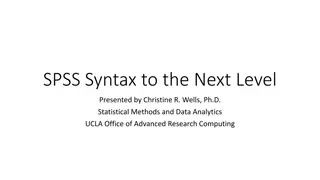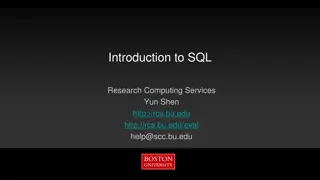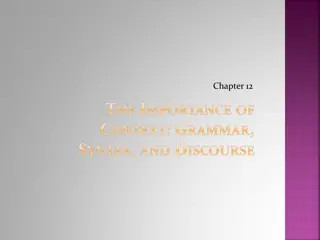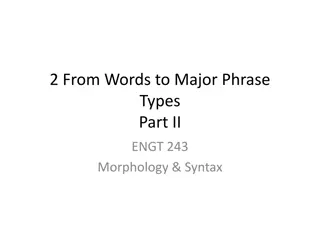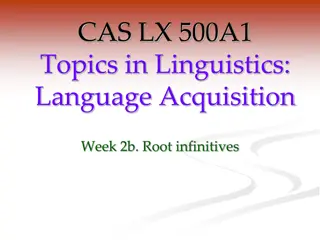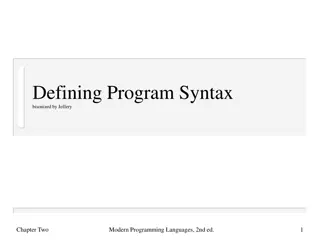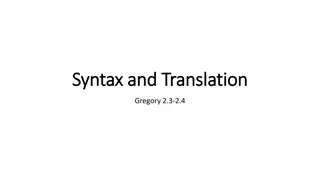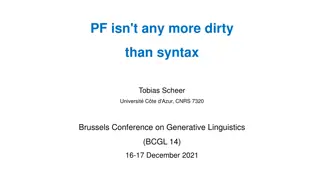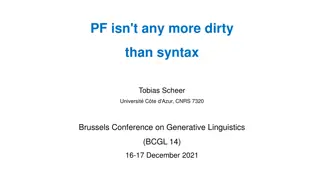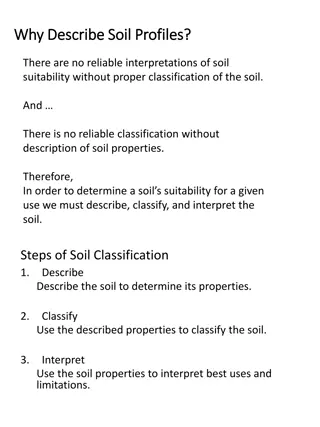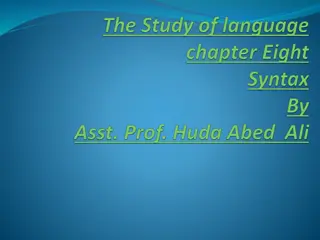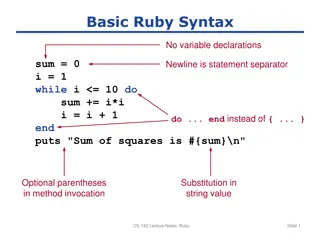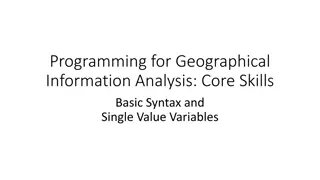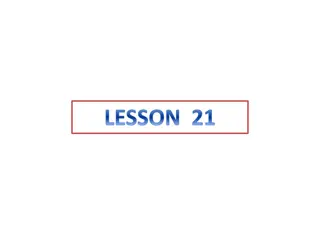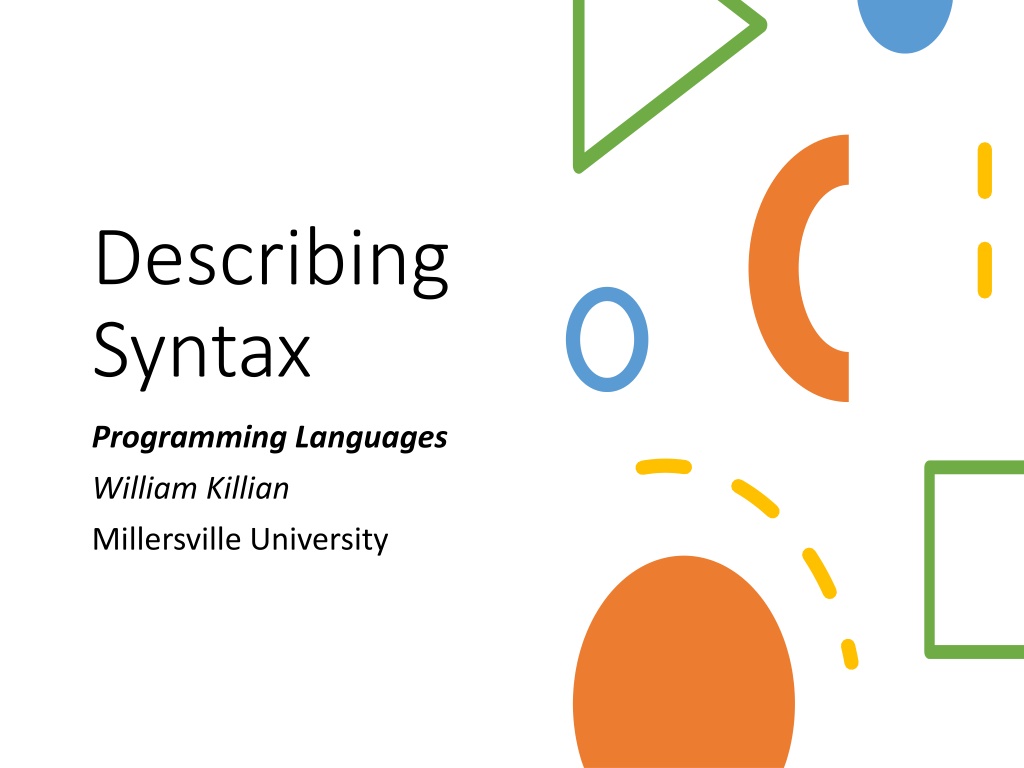
Understanding Syntax in Programming Languages
Explore the fundamentals of syntax in programming languages, including context-free grammars, Backus-Naur Form (BNF), Extended Backus-Naur Form (EBNF), and more. Discover how syntax defines the structure of expressions and statements in languages like C, C++, and Java, and learn about the importance of defining syntax for programming languages.
Download Presentation

Please find below an Image/Link to download the presentation.
The content on the website is provided AS IS for your information and personal use only. It may not be sold, licensed, or shared on other websites without obtaining consent from the author. If you encounter any issues during the download, it is possible that the publisher has removed the file from their server.
You are allowed to download the files provided on this website for personal or commercial use, subject to the condition that they are used lawfully. All files are the property of their respective owners.
The content on the website is provided AS IS for your information and personal use only. It may not be sold, licensed, or shared on other websites without obtaining consent from the author.
E N D
Presentation Transcript
Describing Syntax Programming Languages William Killian Millersville University
Outline Definition of Syntax Defining Syntax Context Free Grammars (CFG) Backus-Naur Form (BNF) Extended Backus-Naur Form (EBNF) Verifying Syntax Derivations Parse Trees Ambiguity
Syntax the form or structure of the expressions, statements, and program units x = 5; is syntactically valid in languages like C, C++, Java [1;2;3] |> List.map pow |> List.fold_left (+) is syntactically valid in languages like Ocaml f +. (0::[]) Just looks like nonsense
Defining Syntax
Defining Syntax Need some way to define the syntax of a language Should be extendable Should be easy to read Should be applicable to all languages Solution: Context-Free Grammars Backus-Naur Form Extended Backus-Naur Form
Context-Free Grammars Developed by Noam Chomsky in the mid-1950s Language generators, meant to describe the syntax of natural languages Define a class of languages called context-free languages Learn more about it in a Computational Models course (CSCI 340)
Backus-Naur Form Created by John Backus (1959) to describe the syntax of Algol 58 Equivalent to context-free grammars Two High-Level Abstractions: Terminals tokens e.g. for 10 :: if int Non-Terminals rules defining part of the language
Backus-Naur Form Rules LHS Nonterminal RHS Combinations of terminals/nonterminals <if_stmt> if <logic_expr> then <stmt> <ident_list> identifier | identifier, <ident_list>
Backus-Naur Form Grammar Grammar: a finite non-empty set of rules A start symbol is a special element of the Nonterminals Defines the root rule of the language <program> <decl_list> <decl_list> <decl> <decl_list> | Epsilon ( ) means nothing Syntactic lists are described using recursion
Example BNF Grammar <program> <stmts> <stmts> <stmt> | <stmt> ; <stmts> <stmt> <var> = <expr> <var> a | b | c | d <expr> <term> + <term> | <term> - <term> <term> <var> | const
Extended BNF Optional parts are placed in brackets [ ] <proc_call> ident [(<expr_list>)] Alternative parts of RHSs are placed inside parentheses and separated via vertical bars <term> <term> (+|-) const Repetitions (0 or more) are placed inside braces { } <ident> letter {letter|digit}
Extended BNF Comparison BNF <expr> <expr> + <term> | <expr> - <term> | <term> <term> <term> * <factor> | <term> / <factor> | <factor> EBNF <expr> <term> {(+ | -) <term>} <term> <factor> {(* | /) <factor>}
Verifying Syntax
Verifying Syntax How can we show that a sequence of tokens match a grammar defined with BNF? Option 1: Generate all possible valid sentences in the grammar and see if it shows up Good idea? Option 2: Intelligently expand rules and backtrack when we encounter an error. When we match (and expanded all non-terminals): Done If we exhaustively tried all options: Fail
Derivation A derivation is a repeated application of rules, starting with the start symbol and ending with all terminal tokens <program> => <stmts> <program> <stmts> <stmts> <stmt> | <stmt> ; <stmts> <stmt> <var> = <expr> <var> a | b | c | d <expr> <term> + <term> | <term> - <term> <term> <var> | const => <stmt> => <var> = <expr> => a = <expr> => a = <term> + <term> => a = <var> + <term> => a = b + <term> => a = b + const This is known as a leftmost derivation because we expanded the leftmost non-terminal each step
Derivation Example Perform a left-most derivation a = 4; b = a + 1 <program> <stmts> <stmts> <stmt> | <stmt> ; <stmts> <stmt> <var> = <expr> <var> a | b | c | d <expr> <term> + <term> | <term> - <term> <term> <var> | const <program>
Parse Tree A Graphical Representation of a derivation <program> <stmts> <stmt> <var> = <expr> a <term> + <term> <var> const b
Ambiguity A grammar is ambiguous if and only if it generates a sequence of tokens that has two or more distinct parse trees <expr> <expr> + <expr> | const <expr> <expr> <expr> <expr> <expr> <expr> + + <expr> <expr> <expr> <expr> + + const const const const const const
Ambiguity If we use the parse tree to indicate precedence levels and associativity of the operators, we cannot have ambiguity <expr> <expr> const + <expr> | const <expr> + <expr> + const const const
Supporting Precedence <expr> <expr> - <term> | <term> <term> <term> / const | const <expr> <expr> <expr> <op> <expr> <expr> <op> <op> <expr> <expr> <op> <expr> <expr> <op> <expr> const - const / const const - const / const


